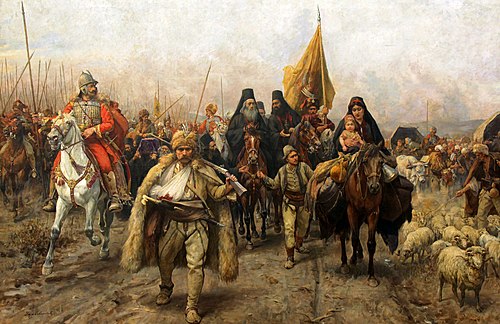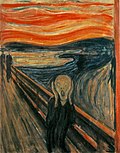Portal:Visual arts
Introduction

The visual arts are art forms such as painting, drawing, printmaking, sculpture, ceramics, photography, video, image, filmmaking, design, crafts, and architecture. Many artistic disciplines such as performing arts, conceptual art, and textile arts, also involve aspects of the visual arts, as well as arts of other types. Within the visual arts, the applied arts, such as industrial design, graphic design, fashion design, interior design, and decorative art are also included.
Current usage of the term "visual arts" includes fine art as well as applied or decorative arts and crafts, but this was not always the case. Before the Arts and Crafts Movement in Britain and elsewhere at the turn of the 20th century, the term 'artist' had for some centuries often been restricted to a person working in the fine arts (such as painting, sculpture, or printmaking) and not the decorative arts, crafts, or applied visual arts media. The distinction was emphasized by artists of the Arts and Crafts Movement, who valued vernacular art forms as much as high forms. Art schools made a distinction between the fine arts and the crafts, maintaining that a craftsperson could not be considered a practitioner of the arts.
The increasing tendency to privilege painting, and to a lesser degree sculpture, above other arts has been a feature of Western art as well as East Asian art. In both regions, painting has been seen as relying to the highest degree on the imagination of the artist and being the furthest removed from manual labour – in Chinese painting, the most highly valued styles were those of "scholar-painting", at least in theory practiced by gentleman amateurs. The Western hierarchy of genres reflected similar attitudes. (Full article...)
Selected article

Seoba Srba (English: Migration of the Serbs) is a set of four similar oil paintings by the Serbian artist Paja Jovanović that depict Serbs, led by Archbishop Arsenije III, fleeing Old Serbia during the Great Serb Migration of 1690–91. The first was commissioned in 1895 by Georgije Branković, the Patriarch of Karlovci, to be displayed at the following year's Budapest Millennium Exhibition. In the view of the Serbian clergy, it would serve to legitimize Serb claims to religious autonomy and partial self-administration in Austria-Hungary by upholding the contention that Serbs left their homeland at the behest of the Holy Roman Emperor to protect the Habsburg monarchy's borders.
Measuring 380 by 580 centimetres (150 by 230 in), the first painting was completed in 1896, and presented to Patriarch Georgije later that year. Dissatisfied, the Patriarch asked Jovanović to adjust his work to conform with the Church's view of the migration. Though Jovanović made the changes relatively quickly, he could not render them in time for the painting to be displayed in Budapest, and it therefore had to be unveiled at the Archbishop's palace in Sremski Karlovci. Jovanović went on to complete a total of four versions of the painting, three of which survive. The first version is on display at the patriarchate building of the Serbian Orthodox Church in Belgrade, the second at the Pančevo Museum, and the fourth at Princess Ljubica's Residence, in Belgrade. Migration of the Serbs holds iconic status in Serbian popular culture, and several authors repute it to be one of Jovanović's finest achievements. (Full article...)
Selected picture
Selected quote
Related portals
Selected biography

Pierre Joseph Rossier (16 July 1829 – 22 October 1886) was a pioneering Swiss photographer whose albumen photographs, which include stereographs and cartes-de-visite, comprise portraits, cityscapes, and landscapes. He was commissioned by the London firm of Negretti and Zambra to travel to Asia and document the progress of the Anglo-French troops in the Second Opium War and, although he failed to join that military expedition, he remained in Asia for several years, producing the first commercial photographs of China, the Philippines, Japan and Siam (now Thailand). He was the first professional photographer in Japan, where he trained Ueno Hikoma, Maeda Genzō, Horie Kuwajirō, as well as lesser known members of the first generation of Japanese photographers. In Switzerland he established photographic studios in Fribourg and Einsiedeln, and he also produced images elsewhere in the country. Rossier is an important figure in the early history of photography not only because of his own images, but also because of the critical impact of his teaching in the early days of Japanese photography. (Full article...)
Did you know (auto generated) -

- ... that the author of Sugar Dog Life ended up buying and raising a cactus after drawing one in the manga?
- ... that Mexican filmmaker David Zonana wrote his first feature film after producing for two other directors?
- ... that to encourage the development of Bissau-Guinean cinema, one foreign filmmaker provided the country's film institute with cameras, lights, and a Steinbeck guitar?
- ... that Mayu Sakai found drawing Peter Pan Syndrome difficult because of its fantasy elements?
- ... that two books of photos and drawings by Margot Dias were called "among the best-illustrated anthropological volumes ever produced"?
- ... that although the icosian game was advertised as a "highly amusing game for the drawing room", it was too easy to play and not a commercial success?
- ... that the art of Irma Blank, of "drawing languages without words" and including sounds, was recognised in the 1970s but fell into obscurity until a rediscovery in the 2010s?
- ... that Io Kaziwara developed tendonitis while drawing the first volume of the manga series Reincarnated into Demon King Evelogia's World?
General images
Major topics
- Types of visual art – Architecture • Art intervention • Ceramic art • Computer art • Drawing • Fashion • Film • Installation art • Land art • Mixed media • Painting • Performance art • Photography • Printmaking • Sculpture • Stained glass; • Artists' Books
- Art history – Pre-historic art • Ancient art • Art of Ancient Egypt • Art in Ancient Greece • Minoan pottery • Scythian art • Roman art • Women artists
- Western art periods and movements – Medieval art • Gothic art • Renaissance • Mannerism • Baroque • Rococo • Neoclassicism • Romanticism • Realism • Modern Art • Impressionism • Symbolism • Fauvism • Proto-Cubism • Cubism • Futurism • Dada • Art Deco • Surrealism • Abstract Expressionism • Lyrical abstraction • Conceptual Art • Contemporary Art • Postmodern art visual arts.
- Eastern and Middle Eastern art – Buddhist art • Chinese art • Islamic art • Japanese art • Laotian art • Thai art • Tibetan art
- Lists – Architects • Art movements • Art periods • Painters • Printmakers • Sculptors • Statues
- Lists of basic topics – Visual arts • Architecture • Film • Painting • Photography • Sculpture
Subcategories

Architecture | Ceramic art | Comics | Crafts | Design | Drawing | Illustration | Film | Glass | Graphic design | Industrial design | Landscape architecture | Multimedia | Painting | Photography | Pottery | Printmaking | Public art | Sculpture | Typography | Mosaic
Artists | Visual arts awards | Artist collectives | Art collectors | Art critics | Art curators | Visual arts exhibitions | Art forgery | Art history | Visual arts materials | Art schools | Artistic techniques |
WikiProjects
Things you can do
Associated Wikimedia
The following Wikimedia Foundation sister projects provide more on this subject:
-
Commons
Free media repository -
Wikibooks
Free textbooks and manuals -
Wikidata
Free knowledge base -
Wikinews
Free-content news -
Wikiquote
Collection of quotations -
Wikisource
Free-content library -
Wikiversity
Free learning tools -
Wiktionary
Dictionary and thesaurus






































































